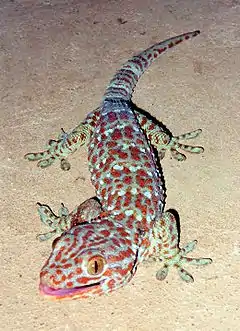Gekko (animal)
Gekko es un género de reptiles escamosos pertenecientes a la familia Gekkonidae. Se distribuyen por el Sudeste Asiático y Oceanía y viven en ambientes húmedos (bosques).[1]
| Gekko | ||
|---|---|---|
 | ||
| Taxonomía | ||
| Reino: | Animalia | |
| Filo: | Chordata | |
| Clase: | Sauropsida | |
| Orden: | Squamata | |
| Suborden: | Lacertilia | |
| Familia: | Gekkonidae | |
| Subfamilia: | Gekkoninae | |
| Género: |
Gekko Laurenti, 1768 | |
| Especie tipo | ||
|
Lacerta Gecko Linnaeus, 1758 | ||
| Especies | ||
Véase el texto. | ||
En su mayoría son insectívoros, a veces con otras fuentes alimenticias tales como frutas, pequeños mamíferos y pequeños reptiles.
Estos animales son principalmente arbóreos, y cuentan con unos dedos adhesivos que les permiten subir casi cualquier superficie.
Especies
Se reconocen las 59 siguientes listadas alfabéticamente según The Reptile Database:[1]
- Gekko aaronbaueri Tri, Thai, Phimvohan, David & Teynié, 2015.
- Gekko adleri Nguyen, Wang, Yang, Lehmann, Le, Ziegler & Bonkowski, 2013.
- Gekko albofasciolatus (Günther, 1867).
- Gekko athymus Brown & Alcala, 1962.
- Gekko auriverrucosus Zhou & Liu, 1982.
- Gekko badenii Szczerbak & Nekrasova, 1994.
- Gekko boehmei Luu, Calame, Nguyen, Le & Ziegler, 2015.
- Gekko bonkowskii Luu, Calame, Nguyen, Le & Ziegler, 2015.
- Gekko canaensis Ngo & Gamble, 2011.
- Gekko canhi Rösler, Nguyen, Van Doan, Ho, Nguyen & Ziegler, 2010.
- Gekko carusadensis Linkem, Siler, Diesmos, Sy & Brown, 2010.
- Gekko chinensis (Gray, 1842).
- Gekko coi Brown, Siler, Oliveros, Diesmos & Alcala, 2011.
- Gekko crombota Brown, Oliveros, Siler & Diesmos, 2008.
- Gekko ernstkelleri Rösler, Siler, Brown, Demeglio & Gaulke, 2006.
- Gekko gecko (Linnaeus, 1758).
- Gekko gigante Brown & Alcala, 1978.
- Gekko grossmanni Günther, 1994.
- Gekko hokouensis Pope, 1928.
- Gekko japonicus (Schlegel, 1836).
- Gekko kikuchii (Oshima, 1912).
- Gekko kwangsiensis Yang, 2015.
- Gekko lauhachindai Panitvong, Sumontha, Konlek & Kunya, 2010.
- Gekko liboensis Zhou, Liu & Li, 1982.
- Gekko melli (Vogt, 1922).
- Gekko mindorensis Taylor, 1919
- Gekko mizoramensis Lalremsanga, Muansanga, Vabeiryureilai & Mirza, 2023.[2]
- Gekko monarchus (Schlegel, 1836).
- Gekko nutaphandi Bauer, Sumontha & Pauwels, 2008.
- Gekko palawanensis Taylor, 1925.
- Gekko palmatus Boulenger, 1907.
- Gekko petricolus Taylor, 1962.
- Gekko porosus Taylor, 1922.
- Gekko reevesii (Gray, 1831).
- Gekko remotus Rösler, Ineich, Wilms & Böhme, 2012.
- Gekko romblon Brown & Alcala, 1978.
- Gekko rossi Brown, Oliveros, Siler & Diesmos, 2009.
- Gekko russelltraini Ngo Van Tri, Bauer, Wood & Grismer, 2009.
- Gekko scabridus Liu & Zhou, 1982.
- Gekko scientiadventura Rösler, Ziegler, Vu, Herrmann & Böhme, 2004.
- Gekko sengchanthavongi Luu, Calame, Nguyen, Le & Ziegler, 2015.
- Gekko shibatai Toda, Sengoku, Hikida & Ota, 2008.
- Gekko siamensis Grossmann & Ulber, 1990.
- Gekko similignum Smith, 1923.
- Gekko smithii Gray, 1842.
- Gekko subpalmatus (Günther, 1864).
- Gekko swinhonis Günther, 1864.
- Gekko taibaiensis Song, 1985.
- Gekko takouensis Ngo & Gamble, 2010.
- Gekko tawaensis Okada, 1956.
- Gekko taylori Ota & Nabhitabhata, 1991.
- Gekko thakhekensis Luu, Calame, Nguyen, Le, Bonkowski & Ziegler, 2014.
- Gekko truongi Phung & Ziegler, 2011.
- Gekko verreauxi Tytler, 1865.
- Gekko vertebralis Toda, Sengoku, Hikida & Ota, 2008.
- Gekko vietnamensis Sang, 2010.
- Gekko vittatus Houttuyn, 1782.
- Gekko wenxianensis Zhou & Wang, 2008.
- Gekko yakuensis Matsui & Okada, 1968.
Referencias
- Uetz, P. & Jirí Hošek (ed.). «Gekko». Reptile Database. Reptarium. Consultado el 12 de marzo de 2016.
- Lalremsanga, Hmar Tlawmte; Muansanga, Lal; Vabeiryureilai, Mathipi; Mirza, Zeeshan A (2023). «A new species of Parachute Gecko of the subgenus Ptychozoon (Sauria: Gekkonidae: Gekko) from the Indo-Burma region». SALAMANDRA 59 (2): 125-135. Consultado el 15 de mayo de 2023.
Enlaces externos
 Wikispecies tiene un artículo sobre Gekko (animal).
Wikispecies tiene un artículo sobre Gekko (animal). Wikimedia Commons alberga una categoría multimedia sobre Gekko.
Wikimedia Commons alberga una categoría multimedia sobre Gekko.
Este artículo ha sido escrito por Wikipedia. El texto está disponible bajo la licencia Creative Commons - Atribución - CompartirIgual. Pueden aplicarse cláusulas adicionales a los archivos multimedia.